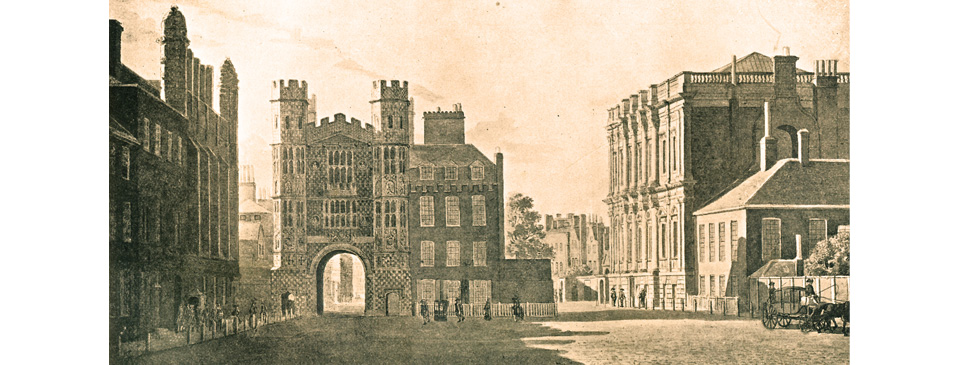Whitehall Palace in the Stuart period

The Holbein Gate of the former Whitehall Palace, with the Banqueting House on the right, as they were in 1743 It is from a drawing by Thomas Sandby, who was employed as a draughtsman at the Tower of London. The gate was removed in 1759 and much of the material acquired by the Duke of Cumberland to be installed at Windsor Great Park under Sandby’s direction.
For almost 160 years Whitehall Palace was the centre of royal life in England, from where Tudor and Stuart monarchs, from Henry VIII in the 16th century to William and Mary in the 18th century, governed the country. In Henry’s reign it was the largest palace in Europe, yet it was never a single grand building. It was more like a royal suburb, a sprawling mass of buildings over 23 acres with no coherent design. Its history stretched back to at least the 13th century.
When Cardinal Wolsey fell from grace, Henry VIII confiscated his substantial palace at Whitehall, just a short distance to the north of the former royal Palace of Westminster. During his reign he transformed it into a more magnificent palace complex. It became a residence for the royal family and courtiers, a venue for state occasions, and a place for royal leisure pursuits such as jousting, bowling, and cockfighting. Immediately to the west of the palace he created a vast hunting ground consisting of St. James’s and Hyde Parks. Queen Elizabeth continued to use the palace in much the same way as her father.
Elizabeth died in 1603. James IV of Scotland, the first of England’s Stuart dynasty, was proclaimed James I, King of England, on the Green beside Whitehall’s Tilt Yard on the same day as Elizabeth’s funeral at Westminster Abbey. By the time of his accession Whitehall was in a dilapidated condition and he hoped to rebuild on a more magnificent scale. Besides, unlike Elizabeth, he had a family that required accommodation. A tennis court was converted into a home for his daughter Elizabeth, new rooms were created on the riverside for the Queen, and lavish residences erected for royal favourites and courtiers. James had Elizabeth’s “old rotten slight-builded” Banqueting House replaced with a sturdier building, completed in 1609.
New stabling was constructed at what is now Trafalgar Square, and various lodgings rebuilt. James also had the Spring Garden created north of the Tilt Yard, named after the spring at that spot. (Although the gardens have long gone, the street at that point still bears the name Spring Gardens).
Following the discovery of the Gunpowder Plot to assassinate James at Westminster in November 1605, Guy Fawkes was interrogated at Whitehall. His reply when asked his intention, was: “To blow Scotchmen back to Scotland”.
Masques were a popular form of entertainment for the royal court during the reigns of Elizabeth, James and Charles I. They were generally plays performed in song and dance, usually based on a classical or allegorical theme, celebrating the host or a particular occasion. The performers were masked. At the performance end the audience joined the final dance, when the actors, often members of the royal court, would unmask to reveal themselves. Extremely large sums of money were spent on extravagant performances. The leading creators of masques were Ben Jonson and Inigo Jones.
Jones was a key figure in the history of Whitehall Palace during the reign of James. He made several trips to Italy where he was able to study classical architecture, as well as stage design. Under the patronage of James’s consort, Anne of Denmark, he designed scenery for masques performed in the Cockpit and Banqueting House at the palace, usually in collaboration with Jonson. In 1613, having completed various architectural commissions, he was appointed Surveyor-General of the King’s Works. He lodged at Scotland Yard, at the north end of the palace complex. Between 1616 and 1635 he designed the Queen’s House at Greenwich. In addition to the work for the royal household, Inigo Jones also undertook numerous other projects, including the creation of the new suburb of Covent Garden and a west front for St. Paul’s Cathedral.
In January 1619 some state apartments were destroyed by fire and the Banqueting House so damaged that it had to be rebuilt. Jones drew up plans for James’s magnificent new palace and work proceeded to create a new Banqueting House on the same site as the old. His design, as with the Queen’s House, was in the Palladian style he had studied in Italy and would have seemed quite magnificent within the surrounding old Tudor buildings. It was completed in 1622. The first masque performed in the new hall was Ben Jonson’s Masque of Augurs in that same year. Banqueting Hall was thereafter used for ceremonial occasions such as state banquets and the reception of ambassadors.
James’s son, the young Prince Henry, Prince of Wales, expanded the art collection started by Henry VIII, and his father had a gallery built by Inigo Jones, known as the Cabinet Room. It stood in the middle of Whitehall, from the Thames to Banqueting House and fronting the Privy Garden. His younger brother, Charles, later increased the collection, particularly with works by Van Dyke.
Despite James’s hope to improve the palace he had inherited most of Jones’s plans were never realised. In reality, they were beyond the financial means of the King. Other than the Banqueting House, the additions made during James’s reign were ad hoc and only rendered Henry VIII’s palace less coherent.


